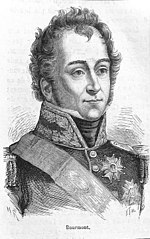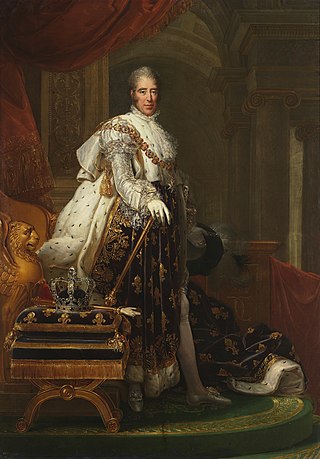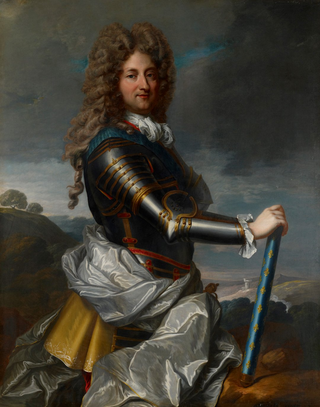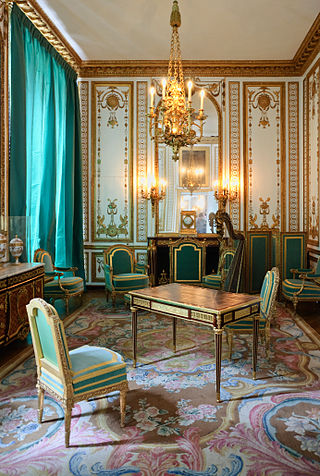Contents
| |||||
| Decades: | |||||
|---|---|---|---|---|---|
| See also: | Other events of 1773 History of France • Timeline • Years | ||||
Events from the year 1773 in France
| |||||
| Decades: | |||||
|---|---|---|---|---|---|
| See also: | Other events of 1773 History of France • Timeline • Years | ||||
Events from the year 1773 in France


Louis XV, known as Louis the Beloved, was King of France from 1 September 1715 until his death in 1774. He succeeded his great-grandfather Louis XIV at the age of five. Until he reached maturity in 1723, the kingdom was ruled by his grand-uncle Philippe II, Duke of Orléans, as Regent of France. Cardinal Fleury was chief minister from 1726 until his death in 1743, at which time the king took sole control of the kingdom.

Charles X was King of France from 16 September 1824 until 2 August 1830. An uncle of the uncrowned Louis XVII and younger brother to reigning kings Louis XVI and Louis XVIII, he supported the latter in exile. After the Bourbon Restoration in 1814, Charles became the leader of the ultra-royalists, a radical monarchist faction within the French court that affirmed absolute monarchy by divine right and opposed the constitutional monarchy concessions towards liberals and the guarantees of civil liberties granted by the Charter of 1814. Charles gained influence within the French court after the assassination of his son Charles Ferdinand, Duke of Berry, in 1820 and succeeded his brother Louis XVIII in 1824.

Philippe II, Duke of Orléans, was a French prince, soldier, and statesman who served as Regent of the Kingdom of France from 1715 to 1723. He is referred to in French as le Régent. He was the son of Monsieur Philippe I, Duke of Orleans, and Madame Elisabeth Charlotte, Duchess of Orléans. Born at his father's palace at Saint-Cloud, he was known from birth by the title of Duke of Chartres.

Louis Philippe II, Duke of Orléans, was a French Prince of the Blood who supported the French Revolution, in the course of which he was executed.

Louis, Duke of Orléans was a member of the House of Bourbon, and as such was a prince du sang. At his father's death, he became the First Prince of the Blood and Duke of Orléans. Known as Louis le Pieux and also as Louis le Génovéfain, Louis was a pious, charitable and cultured prince, who took very little part in the politics of the time.

The Régence was the period in French history between 1715 and 1723 when King Louis XV was considered a minor and the country was instead governed by Philippe d'Orléans as prince regent.

Victor de Broglie, 3rd Duke of Broglie, briefly Victor de Broglie, was a French peer, statesman, and diplomat. He was the third duke of Broglie and served as president of the Council during the July Monarchy, from August 1830 to November 1830 and from March 1835 to February 1836. Victor de Broglie was close to the liberal Doctrinaires who opposed the ultra-royalists and were absorbed, under Louis-Philippe's rule, by the Orléanists.

The 4th House of Orléans, sometimes called the House of Bourbon-Orléans to distinguish it, is the fourth holder of a surname previously used by several branches of the Royal House of France, all descended in the legitimate male line from the dynasty's founder, Hugh Capet. The house was founded by Philippe I, Duke of Orléans, younger son of Louis XIII and younger brother of Louis XIV, the "Sun King".

Louis-Auguste-Victor, Count de Ghaisnes de Bourmont was a French general, diplomat and statesman who was named Marshal of France in 1830. A lifelong royalist, he emigrated from France soon after the outbreak of the French Revolution and fought with the counter-revolutionary Army of Condé for two years, then joined the insurrection in France for three more years before going into exile. He was arrested after assisting the Georges Cadoudal conspiracy, but escaped to Portugal.

Louis-Auguste de Bourbon, duc du Maine was an illegitimate son of Louis XIV and his official mistress, Madame de Montespan. The king's favourite son, he was the founder of the semi-royal House of Bourbon-Maine named after his title and his surname.
The Duke of Luynes is a territorial name belonging to the noble French house d'Albert. Luynes is, today, a commune of the Indre-et-Loire département in France. The family of Albert, which sprang from Thomas Alberti, seigneur de Boussargues, bailli of Viviers and Valence, and viguier of Bagnols and Pont-Saint-Esprit in Languedoc, acquired the estate of Luynes in the 16th century.

Auguste Marie Johanna of Baden-Baden, later Auguste Marie Jeanne, Duchess of Orléans, was a member of the ruling family of Baden-Baden who became Duchess of Orléans as the wife of Louis d'Orléans, Duke of Orléans. Her husband was a grandson of her father's former enemy, Louis XIV of France. Known in France as Auguste de Bade, she died in childbirth. She is an ancestor of Louis Philippe I and of several members of royal families of Europe, such as the Spanish and Italian royal families, as well as the present Grand Duke of Luxemburg.

Marie Anne de Bourbon, Légitimée de France, born Marie Anne de La Blaume Le Blanc, by her marriage Princess of Conti then Princess Dowager of Conti, suo jureDuchess of La Vallière and of Vaujours was a French noblewoman as the eldest legitimised daughter of Louis XIV, King of France, born from his mistress Louise de La Vallière, and the king's favourite daughter. She married Louis Armand I, Prince of Conti, in 1680 and was widowed in 1685. She never married again and had no issue. Upon her mother's death, she became the suo jure Duchess of La Vallière and of Vaujours.
Events from the year 1841 in France.

Louis XVI style, also called Louis Seize, is a style of architecture, furniture, decoration and art which developed in France during the 19-year reign of Louis XVI (1774–1793), just before the French Revolution. It saw the final phase of the Baroque style as well as the birth of French Neoclassicism. The style was a reaction against the elaborate ornament of the preceding Baroque period. It was inspired in part by the discoveries of Ancient Roman paintings, sculpture and architecture in Herculaneum and Pompeii. Its features included the straight column, the simplicity of the post-and-lintel, the architrave of the Greek temple. It also expressed the Rousseau-inspired values of returning to nature and the view of nature as an idealized and wild but still orderly and inherently worthy model for the arts to follow.

Charles Honoré d'Albert de Luynes was a French nobleman and Duke of Luynes. He is best known as the Duke of Chevreuse, his family's subsidiary title which he used until his father's death in 1690. He was a high-ranking French official under King Louis XIV.

Victor Amadeus of Savoy, 3rd Prince of Carignano was an Italian nobleman who was Prince of Carignano from 1709 to 1741. He was the son of Emmanuel Philibert of Savoy, Prince of Carignano and his wife, the Maria Angela Caterina d'Este.
Louise de Maisonblanche, was a French noblewoman, the illegitimate daughter of Louis XIV, King of France and his mistress, Claude de Vin des Œillets. She became the Baroness of La Queue by her marriage to Bernard de Prez.

Marie Sophie de Courcillon was a French salonnière, Duchess of Rohan-Rohan and Princess of Soubise by marriage. She was the granddaughter of Philippe de Courcillon, better known as the marquis de Dangeau. She was praised for being a cultured woman for the age and held a fashionable salon at the Hôtel de Soubise in Paris. She was painted by Nattier.

The Bordeaux copy of the Essays is a 1588 edition of Michel de Montaigne's Essais held by the Bibliothèque municipale de Bordeaux.